Abstract
The immune response to phosphocholine in BALB/c mice involves one group of heavy chain variable region (VH) genes and at least three groups of light chain variable region (V kappa) genes, represented by the gene products of the myelomas TEPC 15, MOPC 603, and MOPC 167/MOPC 511. The amino acid sequences of BALB/c myeloma kappa chains MOPC 167 and MOPC 511 are known, and they differ by six amino acids. We have isolated several closely related V region genes of immunoglobulin light chains from a mouse sperm DNA phage library, selecting clones that cross-hybridize with a cDNA plasmid probe encoding the light chain of MOPC 167. We identified six strongly hybridizing clones, representing three separate cloning events. We determined the sequence of the coding and immediate flanking regions of three clones, representing the three separate cloning events, and they proved to be identical. This germ-line sequence encoded the amino acid sequence of neither MOPC 167 nor MOPC 511, but required four base pair changes to generate the V kappa M167 cDNA sequence and five base pair changes to generate the V kappa M511 gene. By Southern hybridization experiments, we demonstrated that neither MOPC 511 nor MOPC 167 germ-line genes exist. We conclude that the V kappa M167 and V kappa M511 genes are created somatically.
Full text
PDF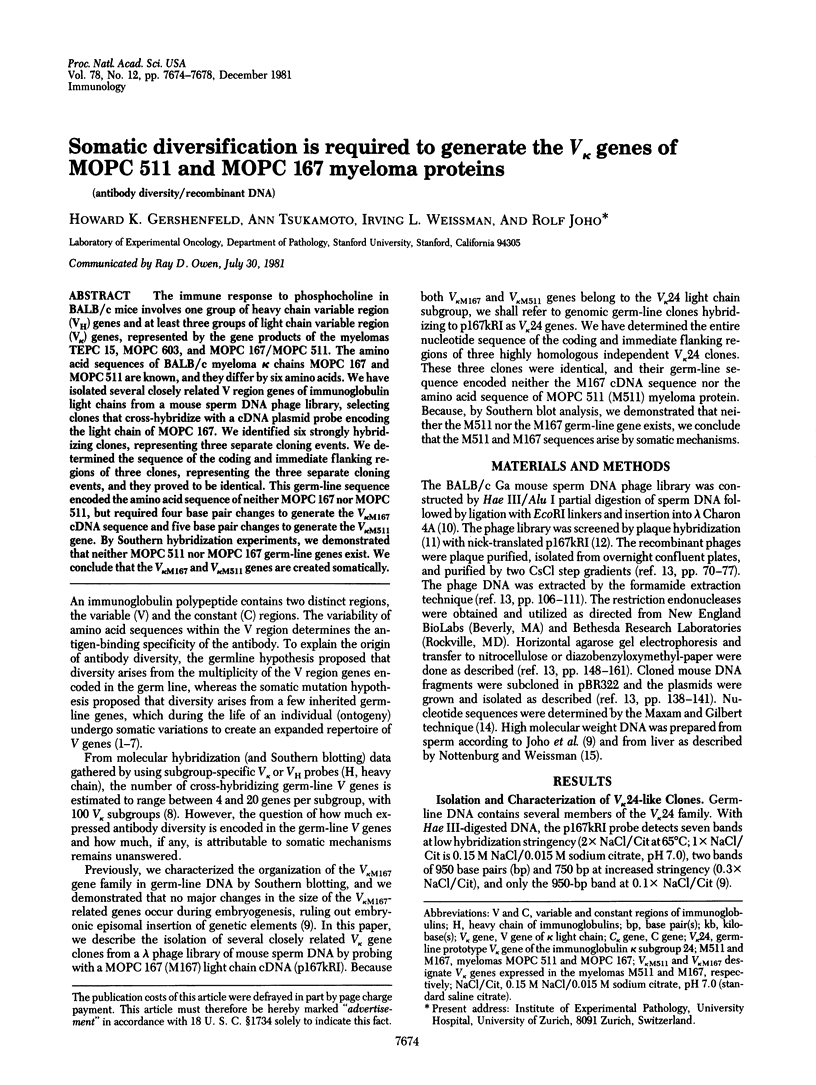
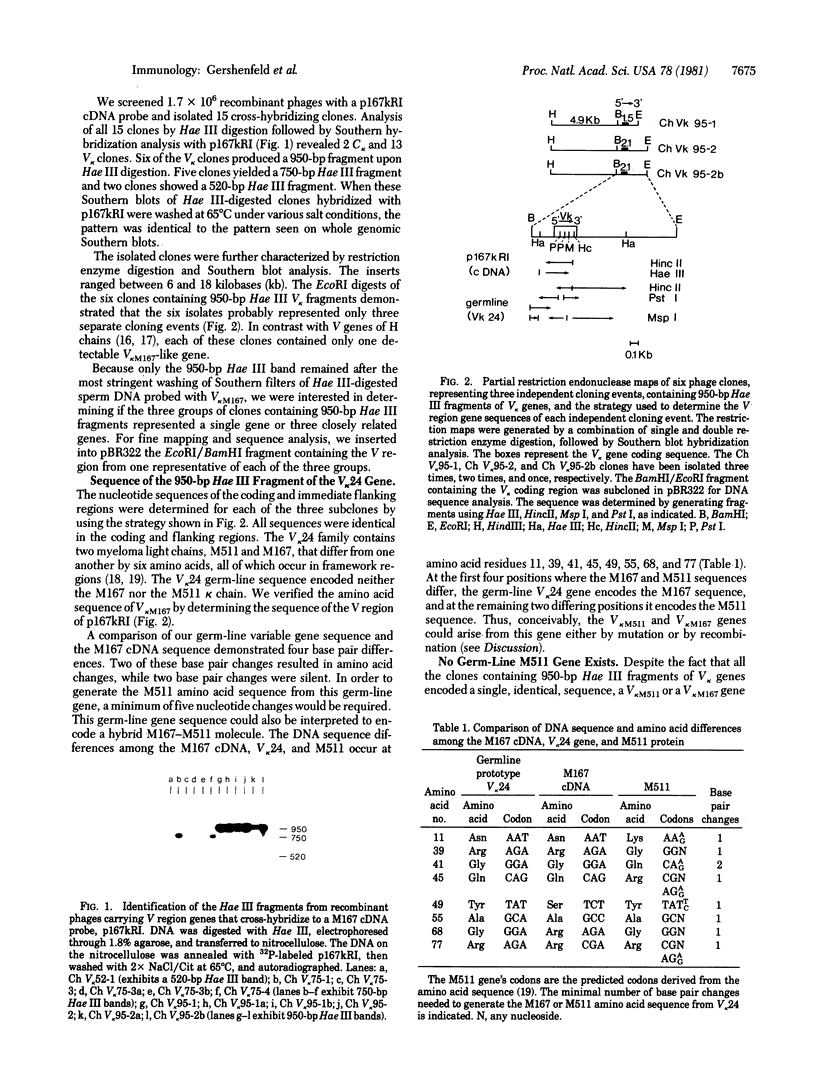
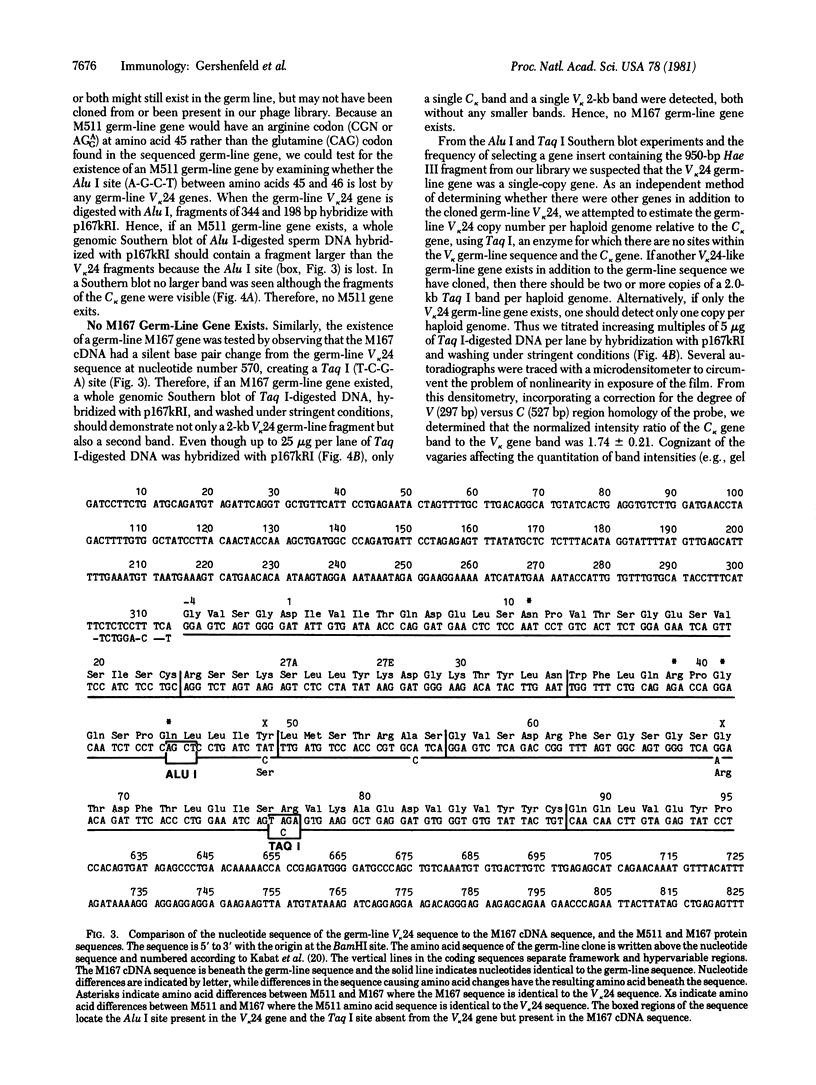
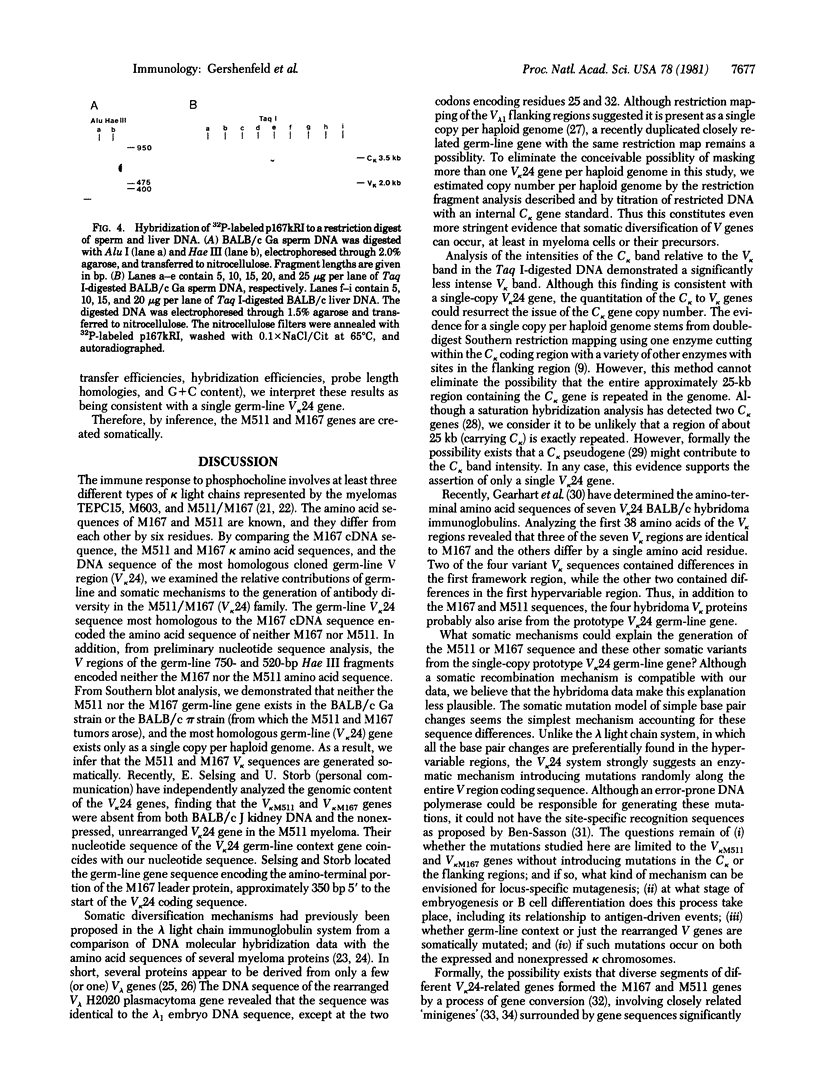
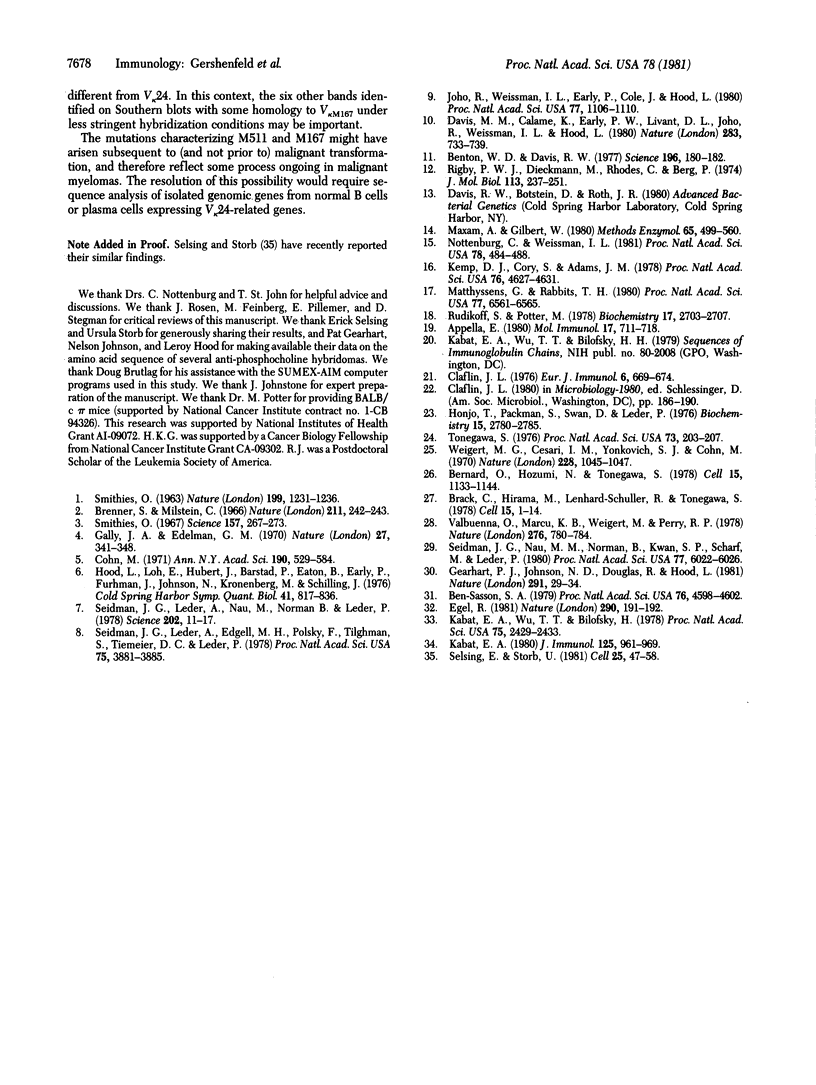
Images in this article
Selected References
These references are in PubMed. This may not be the complete list of references from this article.
- Apella E. Amino acid sequence of the light chain variable region of M511, a phosphorylcholine-binding murine myeloma protein. Mol Immunol. 1980 Jun;17(6):711–718. doi: 10.1016/0161-5890(80)90140-6. [DOI] [PubMed] [Google Scholar]
- Ben-Sasson S. A. Immunoglobulin differentiation is dictated by repeated recombination sequences within the V region prototype gene: a hypothesis. Proc Natl Acad Sci U S A. 1979 Sep;76(9):4598–4602. doi: 10.1073/pnas.76.9.4598. [DOI] [PMC free article] [PubMed] [Google Scholar]
- Benton W. D., Davis R. W. Screening lambdagt recombinant clones by hybridization to single plaques in situ. Science. 1977 Apr 8;196(4286):180–182. doi: 10.1126/science.322279. [DOI] [PubMed] [Google Scholar]
- Bernard O., Hozumi N., Tonegawa S. Sequences of mouse immunoglobulin light chain genes before and after somatic changes. Cell. 1978 Dec;15(4):1133–1144. doi: 10.1016/0092-8674(78)90041-7. [DOI] [PubMed] [Google Scholar]
- Brack C., Hirama M., Lenhard-Schuller R., Tonegawa S. A complete immunoglobulin gene is created by somatic recombination. Cell. 1978 Sep;15(1):1–14. doi: 10.1016/0092-8674(78)90078-8. [DOI] [PubMed] [Google Scholar]
- Brenner S., Milstein C. Origin of antibody variation. Nature. 1966 Jul 16;211(5046):242–243. doi: 10.1038/211242a0. [DOI] [PubMed] [Google Scholar]
- Claflin J. L. Uniformity in the clonal repertoire for the immune response to phosphorylcholine in mice. Eur J Immunol. 1976 Oct;6(10):669–674. doi: 10.1002/eji.1830061002. [DOI] [PubMed] [Google Scholar]
- Cohn M. The take-home lesson--1971. Ann N Y Acad Sci. 1971 Dec 31;190:529–584. doi: 10.1111/j.1749-6632.1971.tb13562.x. [DOI] [PubMed] [Google Scholar]
- Davis M. M., Calame K., Early P. W., Livant D. L., Joho R., Weissman I. L., Hood L. An immunoglobulin heavy-chain gene is formed by at least two recombinational events. Nature. 1980 Feb 21;283(5749):733–739. doi: 10.1038/283733a0. [DOI] [PubMed] [Google Scholar]
- Egel R. Intergenic conversion and reiterated genes. Nature. 1981 Mar 19;290(5803):191–192. doi: 10.1038/290191a0. [DOI] [PubMed] [Google Scholar]
- Gally J. A., Edelman G. M. Somatic translocation of antibody genes. Nature. 1970 Jul 25;227(5256):341–348. doi: 10.1038/227341a0. [DOI] [PubMed] [Google Scholar]
- Gearhart P. J., Johnson N. D., Douglas R., Hood L. IgG antibodies to phosphorylcholine exhibit more diversity than their IgM counterparts. Nature. 1981 May 7;291(5810):29–34. doi: 10.1038/291029a0. [DOI] [PubMed] [Google Scholar]
- Honjo T., Packman S. Quantitation of constant and variable region genes for mouse immunoglobulin lambda chains. Biochemistry. 1976 Jun 29;15(13):2780–2785. doi: 10.1021/bi00658a012. [DOI] [PubMed] [Google Scholar]
- Hood L., Loh E., Hubert J., Barstad P., Eaton B., Early P., Fuhrman J., Johnson N., Kronenberg M., Schilling J. The structure and genetics of mouse immunoglobulins: an analysis of NZB myeloma proteins and sets of BALB/c myeloma proteins binding particular haptens. Cold Spring Harb Symp Quant Biol. 1977;41(Pt 2):817–836. doi: 10.1101/sqb.1977.041.01.092. [DOI] [PubMed] [Google Scholar]
- Joho R., Weissman I. L., Early P., Cole J., Hood L. Organization of kappa light chain genes in germ-line and somatic tissue. Proc Natl Acad Sci U S A. 1980 Feb;77(2):1106–1110. doi: 10.1073/pnas.77.2.1106. [DOI] [PMC free article] [PubMed] [Google Scholar]
- Kabat E. A. Origins of antibody complementarity and specificity--hypervariable regions and minigene hypothesis. J Immunol. 1980 Sep;125(3):961–969. [PubMed] [Google Scholar]
- Kabat E. A., Wu T. T., Bilofsky H. Variable region genes for the immunoglobulin framework are assembled from small segments of DNA--a hypothesis. Proc Natl Acad Sci U S A. 1978 May;75(5):2429–2433. doi: 10.1073/pnas.75.5.2429. [DOI] [PMC free article] [PubMed] [Google Scholar]
- Kemp D. J., Cory S., Adams J. M. Cloned pairs of variable region genes for immunoglobulin heavy chains isolated from a clone library of the entire mouse genome. Proc Natl Acad Sci U S A. 1979 Sep;76(9):4627–4631. doi: 10.1073/pnas.76.9.4627. [DOI] [PMC free article] [PubMed] [Google Scholar]
- Matthyssens G., Rabbitts T. H. Structure and multiplicity of genes for the human immunoglobulin heavy chain variable region. Proc Natl Acad Sci U S A. 1980 Nov;77(11):6561–6565. doi: 10.1073/pnas.77.11.6561. [DOI] [PMC free article] [PubMed] [Google Scholar]
- Maxam A. M., Gilbert W. Sequencing end-labeled DNA with base-specific chemical cleavages. Methods Enzymol. 1980;65(1):499–560. doi: 10.1016/s0076-6879(80)65059-9. [DOI] [PubMed] [Google Scholar]
- Nottenburg C., Weissman I. L. Cmu gene rearrangement of mouse immunoglobulin genes in normal B cells occurs on both the expressed and nonexpressed chromosomes. Proc Natl Acad Sci U S A. 1981 Jan;78(1):484–488. doi: 10.1073/pnas.78.1.484. [DOI] [PMC free article] [PubMed] [Google Scholar]
- Rigby P. W., Dieckmann M., Rhodes C., Berg P. Labeling deoxyribonucleic acid to high specific activity in vitro by nick translation with DNA polymerase I. J Mol Biol. 1977 Jun 15;113(1):237–251. doi: 10.1016/0022-2836(77)90052-3. [DOI] [PubMed] [Google Scholar]
- Rudikoff S., Potter M. kappa Chain variable region from M167, a phosphorylcholine binding myeloma protein. Biochemistry. 1978 Jul 11;17(14):2703–2707. doi: 10.1021/bi00607a001. [DOI] [PubMed] [Google Scholar]
- SMITHIES O. GAMMA-GLOBULIN VARIABILITY: A GENETIC HYPOTHESIS. Nature. 1963 Sep 28;199:1231–1236. doi: 10.1038/1991231a0. [DOI] [PubMed] [Google Scholar]
- Seidman J. G., Leder A., Edgell M. H., Polsky F., Tilghman S. M., Tiemeier D. C., Leder P. Multiple related immunoglobulin variable-region genes identified by cloning and sequence analysis. Proc Natl Acad Sci U S A. 1978 Aug;75(8):3881–3885. doi: 10.1073/pnas.75.8.3881. [DOI] [PMC free article] [PubMed] [Google Scholar]
- Seidman J. G., Leder A., Nau M., Norman B., Leder P. Antibody diversity. Science. 1978 Oct 6;202(4363):11–17. doi: 10.1126/science.99815. [DOI] [PubMed] [Google Scholar]
- Seidman J. G., Nau M. M., Norman B., Kwan S. P., Scharff M., Leder P. Immunoglobulin V/J recombination is accompanied by deletion of joining site and variable region segments. Proc Natl Acad Sci U S A. 1980 Oct;77(10):6022–6026. doi: 10.1073/pnas.77.10.6022. [DOI] [PMC free article] [PubMed] [Google Scholar]
- Selsing E., Storb U. Somatic mutation of immunoglobulin light-chain variable-region genes. Cell. 1981 Jul;25(1):47–58. doi: 10.1016/0092-8674(81)90230-0. [DOI] [PubMed] [Google Scholar]
- Smithies O. Antibody variability. Somatic recombination between the elements of "antibody gene pairs" may explain antibody variability. Science. 1967 Jul 21;157(3786):267–273. doi: 10.1126/science.157.3786.267. [DOI] [PubMed] [Google Scholar]
- Tonegawa S. Reiteration frequency of immunoglobulin light chain genes: further evidence for somatic generation of antibody diversity. Proc Natl Acad Sci U S A. 1976 Jan;73(1):203–207. doi: 10.1073/pnas.73.1.203. [DOI] [PMC free article] [PubMed] [Google Scholar]
- Valbuena O., Marcu K. B., Weigert M., Perry R. P. Multiplicity of germline genes specifying a group of related mouse kappa chains with implications for the generation of immunoglobulin diversity. Nature. 1978 Dec 21;276(5690):780–784. doi: 10.1038/276780a0. [DOI] [PubMed] [Google Scholar]
- Weigert M. G., Cesari I. M., Yonkovich S. J., Cohn M. Variability in the lambda light chain sequences of mouse antibody. Nature. 1970 Dec 12;228(5276):1045–1047. doi: 10.1038/2281045a0. [DOI] [PubMed] [Google Scholar]




